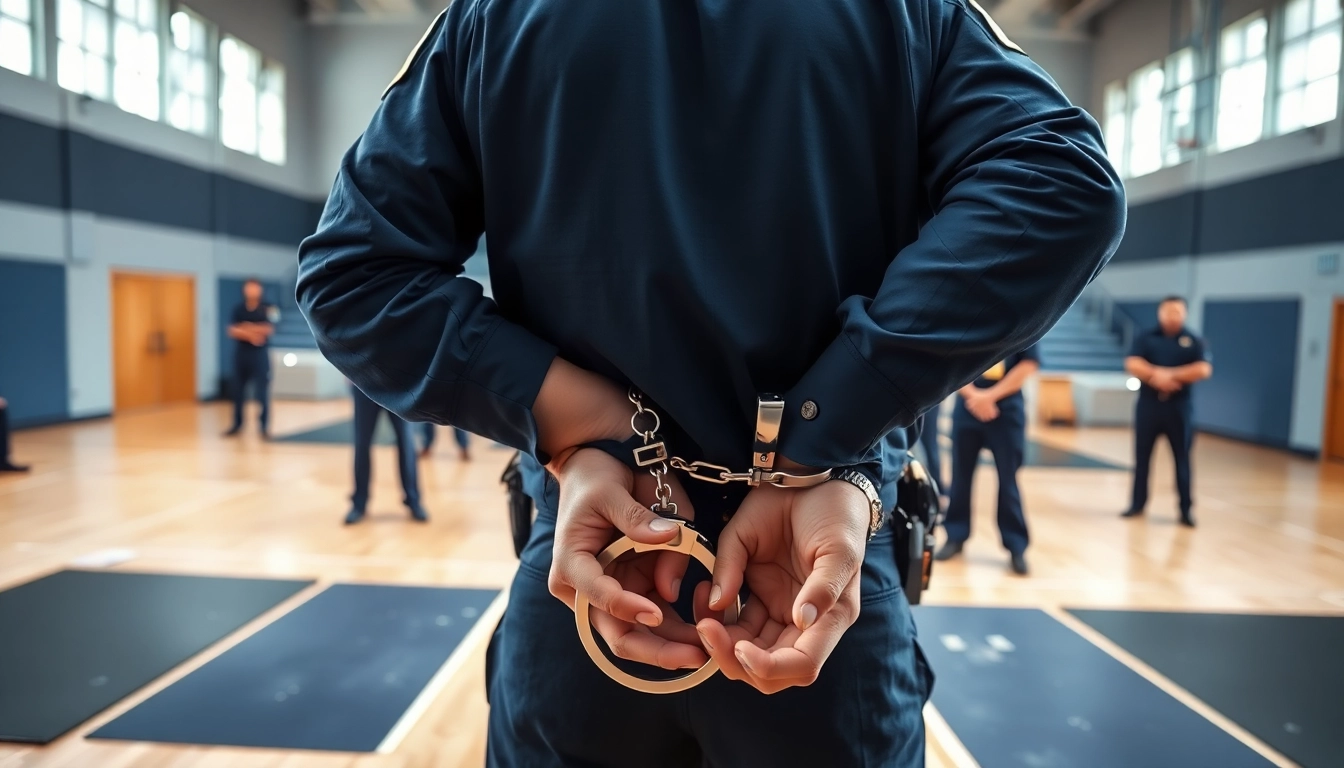Understanding Handcuff Training Basics
In the realm of law enforcement, effective techniques and practical skills are essential for managing confrontations safely and efficiently. Among these skills, handcuff training plays a pivotal role in ensuring both officer and public safety. This article delves into the fundamentals of handcuff training, discussing its significance, essential guidelines, and the techniques involved.
The Importance of Handcuff Training for Law Enforcement
Handcuff training is crucial for law enforcement officers as it equips them with the skills needed to apprehend suspects while minimizing the risk of injury to all parties involved. Officers are often the first line of defense in volatile situations, and proper training instills confidence and competence when performing restraint techniques.
Additionally, effective handcuff training can contribute to better accountability and transparency within law enforcement agencies. When officers are well-trained, the likelihood of excessive force decreases, making interactions with the public safer and more respectful. Furthermore, a solid foundation in handcuffing techniques can help officers reduce their liability in confrontational scenarios, leading to improved community relations.
Key Safety Guidelines for Handcuff Training
Safety is paramount during handcuff training. Here are some essential guidelines that should be followed:
- Always prioritize communication: Engaging with the individual being restrained can defuse potential tensions. Clear instructions should be given to ensure compliance.
- Use approved techniques: Train using standardized methods recognized by law enforcement agencies to promote safety and effectiveness.
- Monitor the individual’s condition: Watch for signs of distress or medical emergencies during the handcuffing process. Adjust techniques accordingly to avoid causing harm.
- Practice regularly: Frequent drills and refreshers will keep skills sharp and ensure that officers are familiar with the necessary procedures.
Common Techniques Used in Handcuff Training
A variety of techniques form the cornerstone of handcuff training. Some common methods include:
- Two-person handcuffing: This technique is useful when apprehending individuals who may be combative or uncooperative. One officer acts as the primary restrainer, while a second officer provides backup support.
- Straight arm and wrist technique: This method is employed to effectively control an individual while reducing the chance of escape. Officers should ensure that the arm is straight and the wrist is bent back slightly to facilitate proper handcuff placement.
- Behind-the-back technique: In many situations, handcuffing an individual behind their back is the safest option. Officers should learn to navigate around potential struggles, directing the individual calmly but firmly during the process.
Essential Skills for Effective Handcuff Training
Understanding the foundational skills necessary for effective handcuff training is imperative. This involves a combination of physical techniques, communication skills, and awareness of body language.
Physical Techniques for Securing Individuals
Physical techniques concern the mechanics of how officers use their bodies to restrain suspects effectively. Officers should be trained to:
- Maintain control: Effective handcuffing requires an understanding of leverage and body positioning. Officers should practice maintaining a strong, stable base to ensure they can control subjects without the risk of being overpowered.
- Aim for quick application: Speed is essential; officers must learn to apply handcuffs quickly and efficiently while minimizing the risk of injury to the individual or themselves.
- Practice different scenarios: Rehearsing a range of real-life situations can prepare officers for various challenges. This includes dealing with resisting subjects and adapting strategies to unique environments.
Communication Skills During Handcuff Training
Effective communication throughout the handcuffing process can significantly impact the outcome. Officers should focus on:
- Clear commands: Directing individuals with assertive yet calm commands can help prevent escalation and promote compliance.
- Active listening: Understanding the individual’s perspective can de-escalate tension. It’s important for officers to listen and respond accordingly to the individual’s verbal cues.
- Verbal reassurance: Using supportive communication reassures the apprehended person and can help maintain control of the situation.
Recognizing Body Language for Safer Restraints
Understanding non-verbal cues is vital, as body language often indicates a person’s intent. Officers should learn to recognize signs of:
- Aggression: Clenched fists, rapid movement, or a tense posture may indicate a potential threat.
- Submission: Relaxed body language may signal a willingness to cooperate, allowing officers to adjust their tactics appropriately.
- Confusion or fear: This can be seen in gestures such as shaking or avoiding eye contact. Recognizing these signs enables officers to respond with more care and understanding.
Advanced Handcuff Training Techniques
Once officers grasp the basics, advanced techniques enhance their skill set, preparing them for more complex scenarios. These techniques often blend established practices with tactical elements.
Combining Handcuff Training with Other Restraint Methods
Advanced handcuff training often involves integrating other restraint methods such as:
- Flex cuffs: For situations that require rapid deployment and minimal space, flex cuffs can serve as an efficient alternative to traditional handcuffs.
- Control holds: Methods such as joint locks or pressure points can provide additional control during an arrest, especially if a subject becomes aggressive.
- Physical barriers: Utilizing walls or vehicles can assist in controlling resisting subjects while effectively restraining them with handcuffs.
Tactical Considerations in Handcuff Training
Effective handcuff training also requires an understanding of tactical considerations, which include:
- Situational awareness: Officers must be trained to assess a scene rapidly, identifying potential risks and determining the best approach for handcuffing.
- Team dynamics: Coordinating with fellow officers to ensure consistent techniques are used during apprehensions can minimize risks and enhance effectiveness.
- Escape routes: Officers should constantly be aware of potential escape routes for the subject and strategize accordingly to prevent them from fleeing.
Incorporating Scenario-Based Training
Scenario-based training provides a practical approach to learning that allows officers to practice skills in realistic situations. Key components include:
- Role-playing: Officers can rehearse various scenarios ranging from routine traffic stops to high-risk situations, allowing them to apply techniques in a controlled environment.
- Feedback opportunities: Post-scenario discussions enable officers to reflect on their performance, discuss what worked, and identify areas for improvement.
- Crisis management: Training scenarios can also focus on including mental health crises or substance abuse situations, providing officers with additional skills to handle diverse challenges effectively.
Challenges in Handcuff Training Implementation
While comprehensive handcuff training can significantly improve officer safety and operational effectiveness, several challenges may arise during implementation:
Overcoming Resistance from Trainees
A common obstacle faced during handcuff training is resistance from trainees. This can occur due to discomfort with physical tactics or skepticism regarding their necessity. Trainers should:
- Foster a supportive environment: Create a culture of openness where trainees feel comfortable discussing their concerns.
- Emphasize real-life applications: Communicating the importance and effectiveness of each technique can help trainees see the value in learning handcuffing skills.
- Encourage peer support: Using experienced officers as mentors can facilitate a smoother learning process and build confidence among trainees.
Addressing Physical Limitations During Training
Some trainees may have physical limitations that can impact their ability to perform handcuffing techniques. Here are ways to address this issue:
- Personalized training: Offering alternatives that accommodate individual capability can bolster trainee participation and effectiveness.
- Focus on strategy over strength: Teach techniques that prioritize leverage and strategy, reminding trainees that they do not need to overpower their subjects.
- Regular assessments: Ongoing evaluations can help identify areas where trainees may require additional support or adaptation.
Evaluating the Efficacy of Handcuff Training Sessions
Evaluating training sessions is vital for continuous improvement. Effective methodologies include:
- Feedback mechanisms: Collecting assessments from trainees post-session can reveal insights into the effectiveness of the training methods used.
- Performance metrics: Developing performance indicators facilitates the objective measurement of trainees’ proficiency and the training program’s overall success.
- Regular refresher courses: Implementing periodic refresher sessions helps ensure officers remain adept at techniques learned during initial training.
Future Trends in Handcuff Training
As law enforcement evolves, so should handcuff training methods. Future trends aim to integrate technology, modern awareness, and innovative practices to reinforce the effectiveness of training programs.
Use of Technology in Handcuff Training
Emerging technologies offer promising advancements in handcuff training, such as:
- Virtual reality simulations: VR training can allow officers to experience realistic handcuffing scenarios without the risks involved in real-life training.
- Wearable analytics: Monitoring officers’ techniques in real-time can provide immediate feedback, optimizing training effectiveness.
- Mobile training apps: These applications can serve as supplemental training resources, providing instructional videos and performance tracking tools.
Adapting Handcuff Training for Diverse Law Enforcement Needs
Law enforcement agencies face varying challenges based on community dynamics and specific operational needs. Adapting handcuff training programs to these contexts can include:
- Tailored programs: Develop custom training that meets the unique needs of different departments, considering the types of environments they typically navigate.
- Community orientations: Engage with community members to understand their perspectives and expectations, helping to align training with broader societal concerns.
- Inclusive practices: Incorporate methods that focus on de-escalation and communication, especially when dealing with vulnerable populations.
Innovative Practices in Ongoing Handcuff Training Programs
Continuous improvement in handcuff training programs can be achieved through:
- Integration of interdisciplinary knowledge: Cross-training with mental health professionals, social workers, or community engagement specialists can enrich the training experience.
- Focus on diversity training: Understanding cultural and regional differences is crucial for effective policing and can enhance the interpersonal skills of officers.
- Promoting wellness: Encouraging a focus on the mental and emotional well-being of officers ensures they are more equipped to handle high-stress situations during training and in the field.

